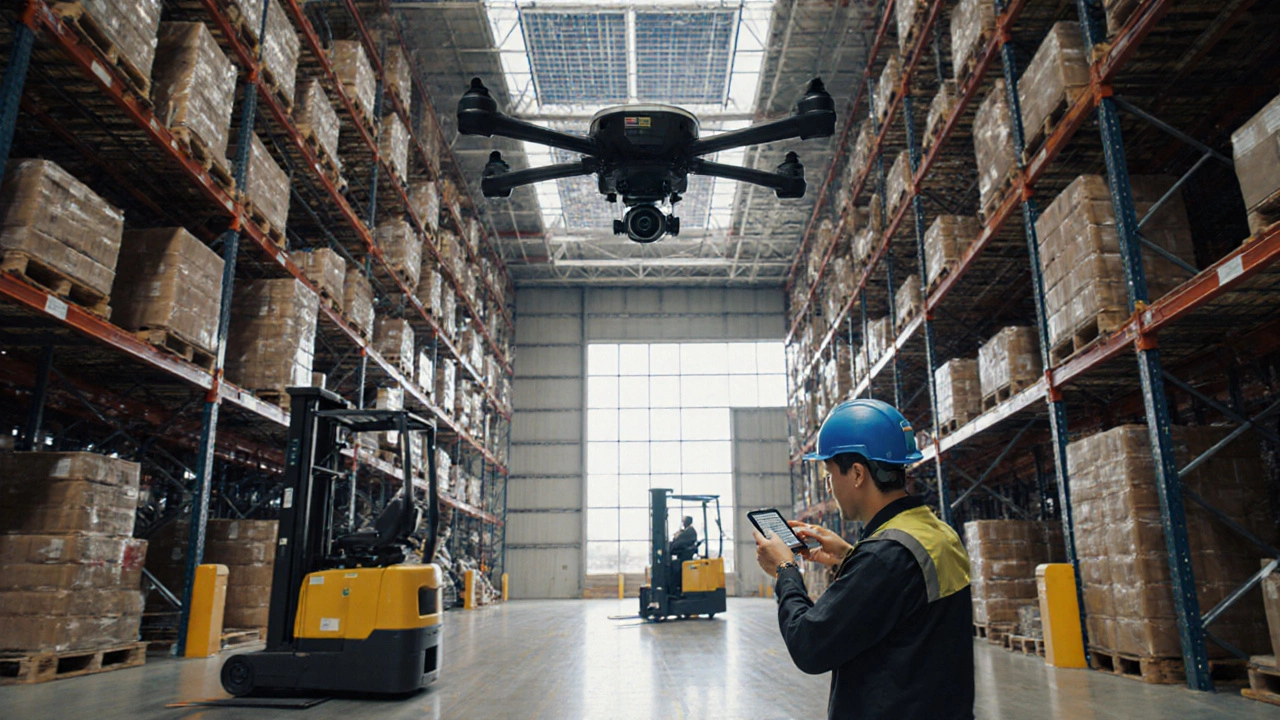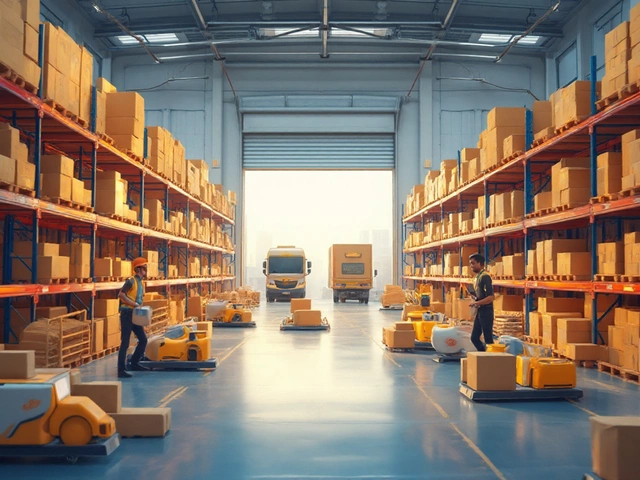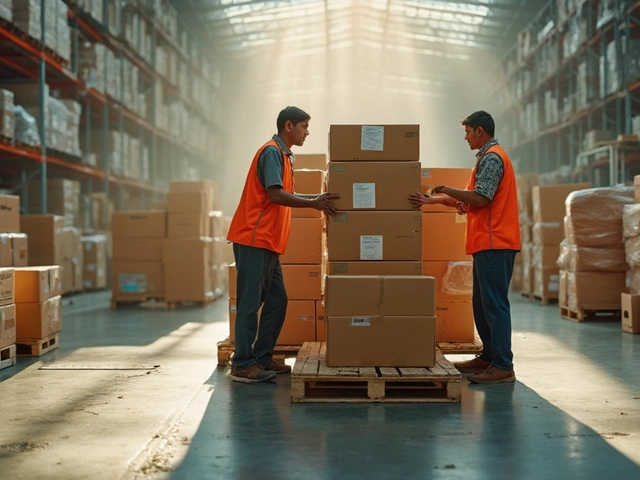Warehouse Automation ROI Calculator
Warehouses aren’t what they used to be. Ten years ago, workers walked miles a day, scanned barcodes by hand, and fought with outdated inventory systems. Today, warehouses are turning into high-speed, self-correcting machines - and the changes are only speeding up. If you’re wondering what the future technology for warehouse operations looks like, it’s not science fiction. It’s already here, quietly reshaping how goods move from factory to front door.
Robotics Are No Longer Optional
Robots in warehouses used to be a novelty shown off at trade shows. Now, they’re the backbone of fulfillment centers. Companies like Amazon, Walmart, and even regional distributors are deploying mobile robots that navigate aisles, pick items, and deliver them to packing stations. These aren’t clunky arms on fixed tracks - they’re autonomous mobile robots (AMRs) with sensors, AI navigation, and real-time communication.
One major warehouse in Ontario reduced picking time by 65% after installing 200 AMRs. The robots handle the heavy lifting - literally. Workers now focus on quality control, packing, and troubleshooting. The shift isn’t about replacing people. It’s about removing the boring, exhausting tasks so humans can do higher-value work.
AMRs now come with built-in load balancing. If one robot gets stuck, others reroute around it. They learn from each other through cloud-based fleet management systems. No more manual scheduling. No more bottlenecks.
AI Is the Brain Behind the Operation
Robots need a brain - and that’s where artificial intelligence comes in. Modern warehouse management systems (WMS) don’t just track inventory. They predict it. Using historical data, weather patterns, delivery windows, and even social media trends, AI forecasts what will sell next week, next month, and where.
For example, a warehouse near Toronto started using AI to anticipate holiday spikes in baby formula and pet supplies. Instead of scrambling to reorder, they pre-positioned stock in regional hubs. Result? 40% faster order fulfillment and 30% less overstock.
AI also handles dynamic slotting - moving products around based on demand. Fast-moving items like toilet paper or energy drinks get placed closer to packing stations. Slow-movers get tucked away. This isn’t done once a quarter. It’s updated hourly. The system learns from every scan, every shipment, every return.
Computer Vision Is Eliminating Human Error
Human error in warehouses costs companies millions. A misplaced box. A mislabeled pallet. A wrong item shipped. Computer vision changes that. Cameras mounted on ceilings, forklifts, and robots scan every item as it moves. They don’t just read barcodes - they recognize shapes, colors, and packaging.
At a distribution center in Mississauga, computer vision caught 92% of mis-picks before they left the building. The system flagged a box of shampoo labeled as “500ml” that actually contained 250ml. No human would’ve noticed unless they weighed every single item. The AI did it automatically.
It’s not just about accuracy. It’s about speed. A worker scanning a barcode takes 3-5 seconds. A camera capturing an image and matching it to a database takes 0.2 seconds. Multiply that by thousands of items per hour - the difference is massive.

Digital Twins Are Revolutionizing Planning
Imagine having a perfect digital copy of your warehouse - down to the last screw, shelf, and robot. That’s a digital twin. It’s not a 3D model you look at on a screen. It’s a live, interactive replica that mirrors real-time conditions.
Warehouse managers use digital twins to test changes before they happen. Want to add 50 new shelves? Run the simulation. Will it block the robots? Will it slow down packing? The twin answers in minutes. No trial-and-error. No downtime.
One logistics firm in Calgary used a digital twin to redesign their layout after a 20% surge in e-commerce orders. They moved receiving docks, repositioned staging areas, and adjusted robot traffic lanes. The real-world rollout took two days. Without the twin, it would’ve taken weeks - and cost them thousands in lost sales.
Edge Computing Keeps Things Fast and Secure
Cloud computing is great for storing data. But when a robot needs to decide in milliseconds whether to stop, turn, or pick up a box, waiting for a server response is too slow. That’s where edge computing comes in.
Edge devices - small computers placed right on the warehouse floor - process data locally. A camera on a forklift doesn’t send video to the cloud. It analyzes it on the spot. If it spots a spill, it alerts a nearby robot to avoid it. If it sees a pallet leaning too far, it triggers an alarm before it falls.
This isn’t just about speed. It’s about security. Sensitive data - like customer addresses or product SKUs - never leaves the building. That’s critical for compliance with Canadian data laws and reducing cyber risks.
Energy Efficiency Is Now a Core Metric
Warehouses are energy hogs. Lighting, HVAC, forklifts, servers - they add up. The future isn’t just about doing more. It’s about doing more with less power.
LED lighting with motion sensors cuts electricity use by 70%. Solar panels on warehouse roofs power half the operations in some facilities. Electric forklifts and robots replace diesel. Even the flooring is changing - anti-static, energy-absorbing materials reduce wear on equipment and lower maintenance costs.
A warehouse in Hamilton installed a smart grid system that shifts high-power tasks to off-peak hours. Running 100 robots at 2 a.m. instead of noon saved them $18,000 a year in electricity alone. That’s not greenwashing. That’s smart business.

Integration Is the Hidden Key
Having robots, AI, and computer vision is useless if they don’t talk to each other. The biggest failure point in modern warehouses isn’t technology - it’s silos.
The best future-ready warehouses use open APIs and standardized protocols like MQTT and OPC UA. These let robots, WMS, ERP systems, and even customer portals communicate seamlessly. A customer orders a product at 11 p.m. The system automatically assigns a robot to pick it, a drone to inspect it, and a truck to leave at 5 a.m. All without human input.
Legacy systems that rely on manual data entry or outdated file transfers are being phased out. If your warehouse still uses Excel for inventory, you’re already behind.
What This Means for Workers
There’s fear that automation will erase jobs. The truth is more nuanced. Jobs are changing - not disappearing.
Warehouse roles are shifting from manual labor to tech support. New positions are popping up: robot technicians, data analysts, AI trainers, cybersecurity specialists for logistics. Salaries for these roles are rising. In Ontario, robot maintenance technicians now earn 40% more than traditional warehouse workers.
Training programs are popping up at community colleges. One program in Brampton teaches workers how to troubleshoot AMRs and interpret AI alerts. Graduates are getting hired before they finish the course.
What’s Next? The Next Five Years
By 2030, warehouses will look almost unrecognizable. Here’s what’s coming:
- Autonomous drones for inventory audits - flying over racks and scanning items in seconds.
- Self-healing systems - machines that detect their own wear and order replacement parts before they break.
- Blockchain for provenance - tracking every item from manufacturer to customer with tamper-proof logs.
- 3D printing on-site - printing replacement parts or even custom packaging inside the warehouse.
The goal isn’t to eliminate humans. It’s to make warehouses smarter, faster, safer, and more sustainable. The companies that win won’t be the ones with the most robots. They’ll be the ones who integrate technology with people - and treat their workers as the most important part of the system.
Is warehouse automation expensive to implement?
Yes, upfront costs can be high - a full automation setup might run $1-3 million for a medium-sized warehouse. But ROI comes fast. Most companies break even in 18-24 months through reduced labor costs, fewer errors, and faster shipping. Many governments, including Canada’s, offer grants for automation and green tech upgrades, which can cut initial costs by 20-30%.
Can small warehouses afford these technologies?
Absolutely. You don’t need to go all-in. Many providers now offer modular, pay-as-you-go solutions. A small warehouse can start with just a few AMRs and a cloud-based WMS for under $50,000. Computer vision cameras and edge devices are also becoming cheaper. Start with one pain point - like picking errors - and scale from there.
How long does it take to implement warehouse tech upgrades?
It depends. A simple WMS upgrade can be done in 2-4 weeks. Adding robots and computer vision usually takes 8-16 weeks. The key is phased rollout. Pilot one area first - say, the picking zone - and expand once you see results. Rushing leads to mistakes. Patience pays.
Do these technologies work with existing systems?
Most modern warehouse tech is built to integrate. Look for systems that support open APIs and industry standards like REST, MQTT, or EDI. Avoid vendors that lock you into proprietary platforms. If your current ERP or inventory software is 10+ years old, you may need a partial upgrade - but you don’t have to replace everything at once.
What’s the biggest mistake warehouses make when adopting new tech?
Focusing only on hardware. The real win comes from training people, redesigning workflows, and changing the culture. A robot can’t fix a broken process. If your staff aren’t involved in the planning, they’ll resist. The best implementations treat tech as a tool - not a replacement.
The future of warehousing isn’t about machines taking over. It’s about humans and machines working together smarter than ever before. The technology is ready. The question is - are you?





